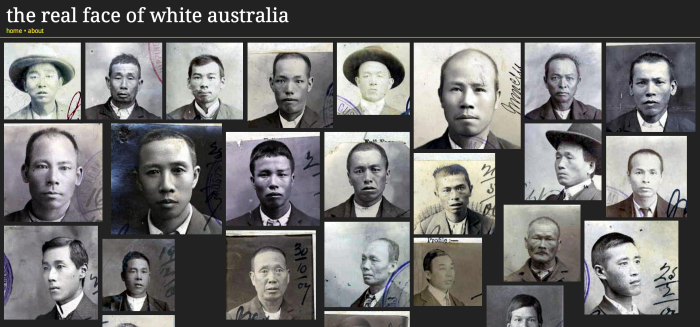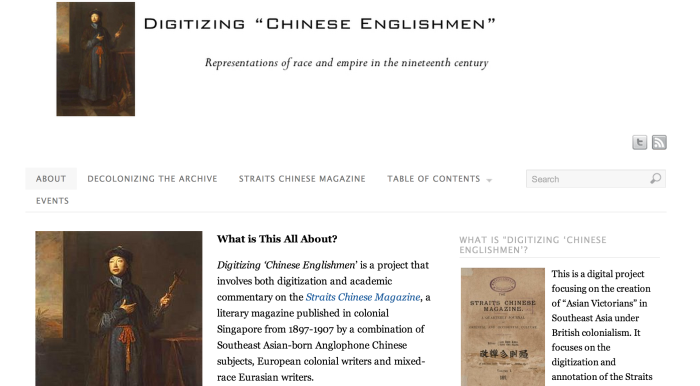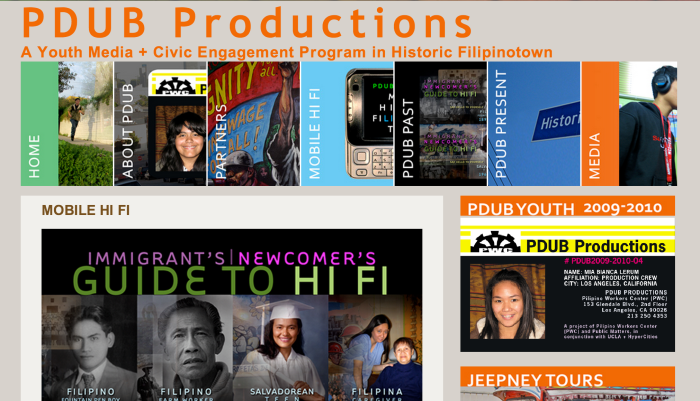Below is the talk I gave as part of a roundtable on race in the digital humanities at CESA2013. It really should have included “Being a Woman of Color in the digital humanities” as part of the title, but much of the presentation was a result of observations I made as the conference approached, and not what I actually wrote in the abstract. I do eventually get to the Asian Am projects toward the end. I also have to admit that this isn’t really the kind of talk I’d give at a “DH” conference (you’ll see why), but there is safety in a space like CESA that we cannot underestimate, and hence the confessions came out when and where they did. (Hopefully, this doesn’t get a ton of people all mad at me!)
For those interested, here is a Storify, compiled by my amazing co-panelist Moya Bailey, of tweets from the entire panel: Representing Race: Silence in the Digital Humanities #CESA2013. Sadly, we were short a few panelists, including Adeline Koh and Jessie Daniels, but we soldiered on and had a productive conversation regardless!
Here we go…
Transformative Asian/American Digital Humanities
I’ve primarily delivered a version of this talk to digital humanities or plain old humanities or language and literature crowds (my own background being in English). Often times it evolves into a joint effort for the panelists to argue for the importance of injecting critical race/class/gender/queerness/ability into dh, but today, my goal is not to argue for just injecting critical race and ethnic studies into dh work or even to DO critical race work using tools and methods of dh, since the spirit of such an endeavor already speaks to ethnic studies work (things like public scholarship, collaboration, interdisciplinarity, process, etc.). For me, and I think for many, if not all of us in this room, anything that we participate in will be infused throughout with our investments to social justice, critical engagement, and also supportive radicalism that comes from our backgrounds in race and ethnic studies. So if we are to participate in digital humanities, to call ourselves digital humanists, we already find it imperative to merge the digital humanities with the historicized and situated knowledge production and engagement offered by the gamut of ethnic studies.
This talk will not try to fit critical race studies to digital humanities, nor even try to define this nebulous DH. I’ll speak briefly about personal experiences as a woman of color in digital humanities and difficulties of entering and participating, but most importantly I want to look at some examples of what I’d consider transformative digital humanities work, specifically Asian American projects, and also the problems and obstacles.
As part of the #transformDH collective, we’ve been suspicious and critical of DH as an area of study, discipline, method that often is overly concerned with what counts, and who has the right to call themselves “digital humanists.” Our work has been to expand what counts as “dh,” to destabilize “dh” as a term that seems to hold increasingly more cache. One of the things #transformDH is careful to do, is interrogate the assumptions that underlie scholarly practice in digital humanities, and the technologies that drive, motivate, and make this work possible. These digital and electronic technologies are of particular importance because they are often perceived as being neutral, without any intrinsic ethics of their own, when they are the result of material inequalities that play out along racial, gendered, national, and hemispheric lines. Not only are these technologies the result of such inequity, but they also reproduce and reinscribe that inequity through their very proliferation and use, which is dependent upon the perpetuation of global networks of economic and social disparity and exploitation.
In general, it is important to integrate Ethnic Studies critique and practice with the digital humanities, as the focus on historical legacy, power structures, economic, political, and social inequity, and their relation to race, gender, sexuality, and class, are necessary to complicate the positivist view of digital technologies from which digital humanities work often unproblematically starts.
My particular goal in the past few years has been to bridge Asian American Studies and digital humanities. Asian Am Studies as a field has seen significant change since its inception in the Civil Rights and student activist movements of the ‘60s and ‘70s and greater institutionalization in recent decades. One thing that we cannot deny, despite the work that has already been done, is that social injustices still persist in varying ways.
For example, from my own experience, I remember attending DH panels at the Modern Language Association in 2011, and Stephen Ramsay’s now infamous talk, “Who’s In and Who’s Out,” in which he provocatively states, “Do you have to know how to code [to be a digital humanist]? I’m a tenured professor of digital humanities and I say ‘yes.’ … Personally, I think Digital Humanities is about building things… If you’re not making anything, you are not…a digital humanist.”
As someone who has studied and taught about exclusion laws, anti-Asian violence, institutional discriminatory practices, and anti-miscegenation laws, I was particularly sensitive to the experience of hearing a tenured professor give a talk entitled, “Who’s In and Who’s Out,” that energetically and aggressively defined the parameters for who can legitimately call themselves “digital humanists” in rather narrow terms. Coding = building? But have we not, since the Civil Rights movement and before, always been building?
Even if Ramsay’s goal was to engender the heated discussion that followed, the experience of being in the room during his session was a rather jarring and marginalizing experience. And it did not help matters that I was one of a handful of women of color in that room, if there were even that many. Later, William Pannapacker, in a blog for The Chronicle of Higher Education, extended this in/out discussion in relation to his own position by writing, “the field, as a whole, seems to be developing an in-group, out-group dynamic that threatens to replicate the culture of Big Theory back in the 80s and 90s, which was alienating to so many people. It’s perceptible in the universe of Twitter: We read it, but we do not participate. It’s the cool-kids table.” But the comparison being made to a “cool-kids table” did not adequately describe my feelings of unwelcome. If anything, it was too benign.
Annemarie Perez in a comment to an open thread hosted by #dhpoco, or Digital Humanities Post Colonial (run by Adeline Koh and Roopika Risam), “Room for Everyone at the DH Table?” a summary of the “The Digital Humanities as a Historical ‘Refuge’ from Race/Class/Gender/Disability?” states: “For people of color, it’s just as hard to be the lonely only. That’s how I felt. Alone and painfully self-conscious. When I’m one of the onlys, however kind and welcoming the environment, I experience stress. There’s a fear of asking questions lest I be seen as speaking for my race / culture and somehow reinforcing biases. I left those DH sessions and moved back into the Chicana/o Latina/o / Asian American / African American literature sessions.” My experience in these panels was similar, distressing since I was and am a really insecure junior scholar in a particularly vulnerable position, and where I hadn’t felt particularly marginalized in my own department I suddenly really felt it here.
My subsequent work with the #transformDH collective, brought together scholars invested in race, gender, queerness, ability, and the digital humanities. (You can learn more about #transformDH by checking out our tumblr, curated by Moya, the Google doc where transformDHers have been gathering to document projects, on twitter with the #transformDH hashtag) Our critique of dh as it had been, our vision and invitation to push it into different and difficult directions was met by a lot of pushback, with some telling us we don’t need to “transform dh,” it’s already transforming the university, or others tweeting at us examples of projects about people of color or women. But as we all know, a project about POC or women, isn’t necessarily a project informed or guided by the principles of feminism, critical race, ethnic or gender studies.
Annemarie Perez, in the same comment that I quoted from earlier, goes on to say, “If DH can learn from cultural studies and feminism to recognize and unsettle its privilege, to demand diversity of itself and its communities, that would go a long way in bridging these discourses. It means not waiting for scholars of color to find DH and ask us about it, but going to them, understanding and listening to their theories and practices and discussing with them how the digital works in connection with the work they’re already doing. We need to understand what it costs for a scholar of color to admit to not knowing or ‘getting’ something and don’t take it lightly.” Thus far, the burden has been on the female scholar, or the scholar of color, to infiltrate the digital humanities, to put ourselves in situations where we are the minority, where we run the risk of being tokenized, to try to work from within and resist being tokenized or marginalized. Often, and I can definitely say this about myself, we are confronted with a strong desire to retreat to our corners of safety, in ethnic studies, in women’s studies, etc. It’s an overwhelmingly strong feeling. DH, at least as I’ve observed, has been very caught up in it’s own internal catfights. There’s a lot of talking about race and gender, (I’m going to get in trouble for saying this) but unproductive back and forth between what appear to be warring factions.*
So, rather than focusing on that… I want to shift gears a bit, and look at some examples of stuff I’d call #transformDH or Transnational Asian/American DH projects. I’ll also try to bring up some of the problems and difficulties these projects encounter, some of which are symptoms of DH projects at large, and others specific to ethnic studies departments and programs which tend to receive less funding, especially in recent years when funding agencies like NEH have been funneling ever larger amounts of money towards projects in big data, databases, digitization projects, digital tool development, online education, etc…:
The Invisible Australians Project
This is a beautiful project by Kate Bagnall and Tom Sherratt that contextualizes and critiques the early 20th century national policy that defined Australia as a white nation. The project uses facial recognition technologies on archived photo identification paperwork from the period to find non-white (mostly Chinese) Australians. It produces a navigable database interface where users can explore the diversity of a so-called “white” country. It’s not unproblematic (I mean, the premise is that it uses technologies to identify ethnic others)**, but still a valuable project in archiving and making public this little-known history.
Digitizing Chinese Englishmen
Digitizing Chinese Englishmen is a project out of Richard Stockton College, run by #dhpoco co-founder Adeline Koh. She cites projects like Africa is a Country, which work to complicate representations of Africa and African diaspora. The project takes as its objective, the preservation of historical documents that diversify and complicate representations of “Englishmen” and “Chinese” during the Victorian era. At the same time, it also endeavors to decolonize the archive, an institution that continues to reproduce the problematic politics of documentation, preservation, and exclusion. Accessible to a wider public through an open website, Digitizing “Chinese Englishmen” also engages with a larger community of students and scholars through social media, thus expanding the audience that might otherwise be excluded from accessing such historical documents and the associated theoretical critiques. (A major problem for those working in non-western contexts, is the inaccessibility of archival materials, the red tape is a major obstacle in many countries.)
PDub Productions
From their website: “PDub Productions is an innovative youth media + civic engagement program through which youth create digital content about Historic Filipinotown (Hi Fi) for distribution on multiple platforms: interactive Mobile Hi Fi Tours; Hypercities, an online, map-based time travel application; and a street-level multimedia installation at Pilipino Worker’s Center’s new building.” Primarily a community project, the Hypercities component came out of classes at UCLA, and Hypercities itself is a robust mapping platform that was produced under the leadership of Todd Presner of the UCLA Center for Digital Humanities. Sadly, Hypercities is no longer supported, as funding ran out, and even staff and faculty at UCLA do not suggest people taking up the platform because there is no tech or institutional support. (I know this from personal experience) The sustainability issue we see here is a major issue with DH projects, even ones that have many applications like this one.
This is my own project, which I’ll be integrating into classes this year. It is built on the free tumblr platform as a means to use the linear blog form to archive digital materials (news coverage, videos, excerpts of literature, art, etc.) that pertain to precarity, migration, labor, temporary work, etc. The platform is restrictive, but initially chosen because of accessibility, the low barrier to entry, and to play with the notion of tumblr as a site for tweens. As with many dh projects, it is heavily dependent on the time and resources I can devote to it. I haven’t received any submissions (despite my tweets and facebook posts), and so it is updated sporadically, when I run across texts, or when I search for them. It also tends to fluctuate based on my own anxieties… right now there’s a lot of stuff up there on precarious labor in academia. I want to emphasize the immaterial labor that is expected of digital humanists and junior scholars who are told they need to tweet, blog, etc. to build up their public profiles in order to find jobs. It is time consuming, and unsustainable unless we can find ways to keep ourselves and our projects running, find communities of people to help us build and maintain them.
* Note: I said this at the panel, but wanted to reiterate: As much as I critique dh, I do identify as a member of this community, I know there is some amazing work being done throughout the community, and I owe so much to these networks for helping me to form my own loving and transformative dh community.
**I misunderstood the original dataset, but clarification from Bethany Nowviskie (see comments below) underscores how thoughtful this project really is, and not as problematic as I originally thought, as the original archive of image only included people of color who were petitioning for exemptions from tests being required of non-European immigrants. My bad!




Pingback: Editors’ Choice: Race in DH – Transformative Asian/American Digital Humanities : Digital Humanities Now
I really enjoyed reading this! Thank you! Just a word that rumors of Hypercities’ demise are greatly exaggerated. 😉 HC is still up and running, and still supported by a team here at UCLA. It is at a transition point — as with a lot of large-scale digital humanities projects, we’re figuring out how it should be sustained in the long run — but “out of money” is, I think, an oversimplification. And I’m afraid I’m the mysterious tipper who recommended against using it in your class! In that case, it really didn’t have to do with HC’s long-term prospects so much as about the burden of training required for students to gain familiarity with HC in order to use it for a class project.
But no need to fear! Hypercities is doing fine; in fact Todd Presner’s using it for his amazing service learning class this year, in which students interview Holocaust survivors and document their stories on the platform. Previous years’ work has been incredible.
Again, thank you for this really valuable piece.
Thanks so much for clearing this up, Miriam! Yoh actually also warned against using Hypercities, saying that if we run into problems in the class there’s no tech support team… Which seems odd, since there seems to be a team through CDH that could support it. Maybe he misunderstood. Maybe he just didn’t want to have to teach students how to use it. 😉 Todd’s teaching and work with Jewish American oral histories and HC is so amazing! I want to share all the things!
Pingback: Tell me about your Asian/Asian Am Digital/DH work! | Anne Cong-Huyen
Pingback: Talk: Race in DH: Librarians’ Responsibilities | THATCamp Digital Humanities & Libraries 2013
I want to add my thanks to Miriam’s for this great post — and also to offer a further small correction to your discussion of Tim Sherratt and Kate Bagnall’s “Invisible Australians” project. You suggest that it’s problematic because it’s using technology to “identify ethnic others.” In fact, the archival collection on which Tim runs his facial-detection script only contains images of “non-white” Australians — so the script is simply detecting faces in general, and so that the site can present them in a way that emphasizes the people rather than their surrounding paperwork. The photos were taken under the White Australia Policy, of people who wanted to be exempted from a dictation test imposed on non-European immigrants when they attempted to return to Australia from travelling overseas. Kate has a terrific post reflecting on the project, and on how they’ve tried to make their use of the photographs “respectful and decent:” http://chineseaustralia.org/archives/1389
Thanks for this clarification, Bethany! That makes all the difference. Had missed this post, which is really helpful. Ultimately, it really is such an important (and gorgeous!) project.
Pingback: Understanding #DH: What’s Race Got to Do with It? | POPdoctorate
Pingback: Never Neutral: Critical Approaches to Digital Tools & Culture in the Humanities | Josh Honn